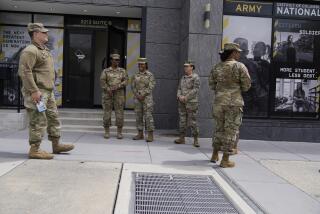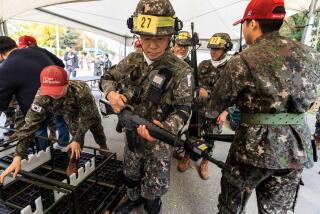Army Holds Its Ground in Battle With Rumsfeld
WASHINGTON — Gen. Eric Shinseki, the Army’s chief of staff, is helping to direct a low-intensity war in Afghanistan and preparing for a possible invasion of Iraq. But his most formidable adversary these days is on the third floor of the Pentagon: Defense Secretary Donald H. Rumsfeld.
In the last year, Rumsfeld cut Army weapon programs and relegated the nation’s oldest armed service to a supporting role in war plans for Afghanistan and Iraq. His moves left Army brass struggling to regain the service’s traditional dominance -- and funding -- in the new war on terrorism.
Now the Army has finally won one. Sources say Rumsfeld will spare from planned budget cuts a light-armor program that Shinseki says is critical for remaking the Army into the more high-tech, faster-moving strike force that the Defense secretary is demanding.
The fight over the multibillion-dollar Stryker program gives insight into the powerful clash of philosophies and wills sparring inside the nation’s defense establishment as the world’s only superpower decides how it should best defend itself against future enemies.
In saving Stryker, the Army -- after suffering one rejection after another -- gained both the sense that it can reach common ground with Rumsfeld and that it can control its fate as it works to reposition itself closer to the center of U.S. war plans for the 21st century.
Shinseki came up with the idea for revamping six existing Army brigades as Stryker brigades even before Rumsfeld ordered the military to remake itself for the global war on terrorism. Shinseki envisioned six brigades of 3,500 men each, outfitted with fast-moving wheeled troop carriers, heavy weaponry and high-tech communication equipment. They would deploy anywhere on the globe within four days and fight smart when they got there.
The plan was to turn out the first brigade by May 2003, then one a year through 2008. Named for two Medal of Honor winners, the brigades would provide a medium-weight force of troops who would move to battle faster than they can in tanks, and arrive with heavier weapons and greater protection than light infantry.
Traditionally, Army tanks would simply run into the enemy and start firing. With the Stryker, small unmanned planes flying overhead give an instant picture of the battlefield day or night, allowing soldiers to fire on the enemy before being spotted.
The lightly armored Stryker personnel carriers look like a cross between a Humvee and a tank and allow groups of 11 men to reach remote areas in rough terrain at more than 50 mph. A cannon mounted on top of the Stryker can be fired remotely, sparing soldiers exposure to enemy fire.
Each planned brigade is expected to cost about $1.5 billion, and will be equipped with 309 Stryker vehicles, at a cost of $1.5 million to $3.5 million each.
It all seemed tailor-made to Rumsfeld’s vision of a leaner, lighter war machine for the challenges of the global war on terrorism -- and it was scheduled to begin deploying in time to help with a possible mission in Iraq.
But to Shinseki’s dismay, Rumsfeld’s budget aides this fall said they were considering slashing the planned six brigades to three. The proposal was seen as a vote of no-confidence not only in Stryker, but in the army’s efforts to modernize.
Without Stryker, Army officials fretted, they would be unable to fulfill the mission Rumsfeld had laid out for them.
Determined to preserve Stryker, the Army launched a bureaucratic and public relations war aimed at breaking its string of losing battles with Rumsfeld.
Shinseki and Army Secretary Thomas E. White, the service’s top civilian leader, began a charm offensive to persuade Rumsfeld’s Pentagon that Stryker was exactly the sort of innovative program they were looking for from the Army. And they argued that the military needed the technology-laden Stryker troop carriers in Afghanistan and, possibly, Iraq.
Officially, both Rumsfeld and budget aide Stephen A. Cambone say the final decision on Stryker will be made in the next few weeks. And sources in Rumsfeld’s office cautioned there are still questions that must be answered.
“We’re looking for the Army to come back with a plan that will make this more of a fighting force than they now have,” said a senior defense official familiar with the negotiations.
But industry, Army and other defense officials said this week they have strong indications that the program will be spared. The 2004 defense budget Rumsfeld is to send to the White House next month will include some strings, but the program will be kept intact.
The gap between the Army and its civilian leader has been largely philosophical.
Rumsfeld, a former Navy aviator, has presented a clear, if controversial, vision of modern warfare, one that uses fewer infantrymen and relies more on precision airstrikes and on small groups of special operation soldiers. He has sought cuts to fund an elaborate missile-defense system, unmanned planes and satellite-guided bombs.
Army leaders, who still insist that some military engagements will require large ground battles, have grown increasingly alarmed about what role their service plays in Rumsfeld’s vision.
“My impression is that Rumsfeld is looking to fight wars without armies,” said Ivo Daalder, a former National Security Council official and military analyst with the Brookings Institution, a Washington, D.C., think tank. “His philosophy is that you can now fight wars without blood, that you can do it from on high, that you can destroy targets -- without actually having to get mud on their boots. But in the end, you achieve your objective by having boots on the ground.”
Two years ago, Shinseki and Rumsfeld seemed natural allies in modernizing the Army. Shinseki became the father of military transformation in 1999 when he ordered the Army to become faster and lighter. A year later, after Rumsfeld returned for a second stint as Defense secretary, he ordered all four services to do the same.
Yet having the idea first did not seem to help Shinseki with his new boss.
Rumsfeld quickly served notice that the Army had to work harder to re-create itself. He started by killing the Army’s Crusader artillery system, criticized as too heavy and too oriented toward Cold War-style conflicts. Then he cut the Army’s Comanche helicopter program nearly in half. The secretary then seemed to undermine Shinseki by announcing his replacement -- his deputy, Gen. John Keane -- 15 months before Shinseki’s retirement. Shinseki reportedly first read the news in the Washington Post.
Shinseki and Rumsfeld’s offices have played down the conflict and called negotiations over the Stryker program “amiable.” Deputy Secretary of Defense Paul D. Wolfowitz, when asked by an interviewer whether Rumsfeld is anti-Army, replied tersely: “Definitely not. That’s a simple question to answer.”
Army officials say they improved tense relations with Rumsfeld and his civilian leaders by showing how Stryker could be ready for battle soon -- and by changing their tactics.
With Crusader, the Army largely ignored Rumsfeld and tried to save the program by lobbying Congress. With Stryker, one Army official involved in the campaign to save the program said, “We did exactly the opposite of what we did with Crusader.”
Shinseki took the unusual step of hiring two public relations firms to make the Army’s case. At one point, the Army called a news conference to demonstrate that critics were wrong when they said Stryker couldn’t fit into a C-130 cargo plane. As reporters watched, one of the vehicles was driven into the giant plane’s hold.
Hoping to highlight the brigades’ usefulness to Pentagon planners, Army strategists used the units -- which will not be certified as fit for duty until May -- in a mock postwar cleanup mission last week at the former George Air Force Base in Victorville. Soldiers were patrolling the fictional nation of Pacifica, based roughly on the Philippine island of Luzon, after an invasion by fictional neighbor Surran. On a mission to halt infiltration by guerrillas and to buttress the tottering Pacifica regime, they sought to make allies of local officials.
Each group entered Pacifica in Strykers with operators viewing an infrared computer screen that revealed a moonless predawn landscape as if it were twilight. If a drone or Stryker operator identifies an enemy, a red diamond appears instantly on computer screens in every vehicle and command post, giving an instantaneous picture to platoon leaders on foot who otherwise would rely on radios and hand-marked maps.
Stryker advocates hope that if the first brigade is not ready in time for a possible war with Iraq, it could help stabilize the region in its aftermath.
“The best selling point for this brigade is the utilization of it. We’ve got to get it out there,” said Lt. Col. Jim Cashwell, a battalion commander who oversaw the exercise. “The question is, where?”
*
(BEGIN TEXT OF INFOBOX)
Going lighter
Smaller and lighter than the Abrams tank, the Stryker Mobile Gun System would be a central component of the Army’s Stryker brigade, the lightly armored units that would consist of 3,500 soldiers each.
*
Stryker Mobile Gun System
Length: 22 feet, 11 inches
Width: 8 feet, 11 inches
Height: 8 feet, 10 inches
Weight: 20.6 tons
Armament: 105-mm cannon, two 7.62-mm machine guns
Max. speed: 60 mph
Max. range: (@40 mph) 330 miles
Crew: 3 (commander, driver, gunner)
*
M1 Abrams
Length: 32 feet, 3 inches
Width: 12 feet
Height: 7 feet, 9.5 inches
Weight: 63 tons
Armament: 120-mm cannon, one .50-caliber, two 7.62-mm machine guns
Max. speed: 42 mph
Max. range: 275 miles
Crew: 4 (commander, gunner, loader, driver)
*
Sources: Globalsecurity.org; General Motors Defense;
*
Researched by Times graphics reporter Tom Reinken
More to Read
Sign up for Essential California
The most important California stories and recommendations in your inbox every morning.
You may occasionally receive promotional content from the Los Angeles Times.










